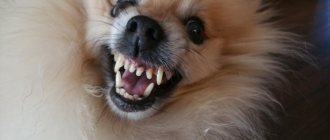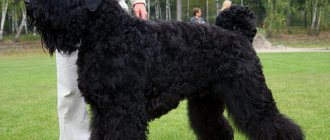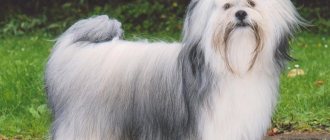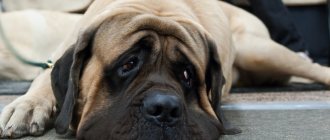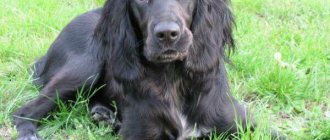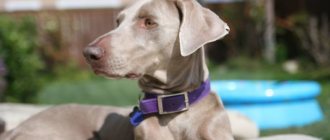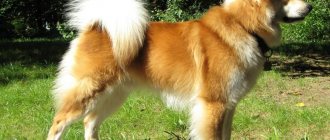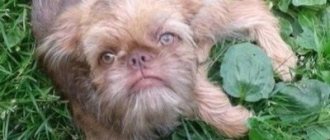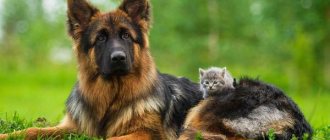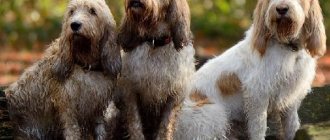History of the Great Dane breed
Great Dane
Today, scientists identify a whole group of large breeds, united by the name “Mastiff Dogs”. In addition to the Great Danes themselves, it includes mastiffs, bulldogs, St. Bernards, Dalmatians, Rottweilers, Newfoundlands, and Leonbergers. It is believed that they all descended from one ancestor - the Tibetan Great Dane. This breed is considered one of the oldest service breeds; the first documentary evidence of its existence dates back to the 12th century BC. Huge, strong dogs have been used for centuries to guard mountain monasteries, hunt large predators and protect herds of nomads. Over time, the breed spread throughout the region. Tibetan dogs were very popular in India, Persia and other Asian countries. There they began to be used as military “weapons” on the fields of military battles, which significantly increased the value of animals. According to Persian law, killing such a dog was a crime even more serious than causing the death of a person, which was reflected in the amount of the fine imposed on the culprit.
Archaeological finds indicate that Tibetan mastiffs took part in numerous campaigns of King Xerxes, including the suppression of uprisings in Egypt and Babylon and the protracted Greek campaign. It is possible that the winners received not only weapons and gold, but also war dogs as trophies. Images of Great Danes are found on coins of Ancient Greece, and in Corinth a monument was even erected to them for their services in the battles with the Peloponnese. Aristotle in his writings paid tribute to the incredible power and natural strength of fighting dogs.
It is not surprising that his pupil and one of the greatest commanders in world history, Alexander the Great, became an ardent admirer of the Molossians (that’s what furry immigrants from Tibet were called in Europe). The Romans also liked the mighty dogs. In peacetime, Great Danes were “kept in shape” by being forced to fight in the ring along with the most dangerous wild animals; during campaigns they invariably accompanied the troops. Together with legionnaires and traders, the animals landed on the British Isles and ended up in the territory of modern Germany, France and Scandinavia.
Images of huge dogs are found on runic stones that have survived to this day, mention of them is found in the Old Icelandic epic, the Elder Edda, and the collection of the Natural History Museum of Denmark boasts seven skeletons of giant hunting dogs that lived between the 5th century BC, found during excavations. . e. and X century AD e.
In a word, the Great Danes had their own Great Migration. And by the 19th century, in different regions of the Old World, several populations of different physiques and colors, but invariably strong and large Molossians, were bred.
The time for large-scale ancient campaigns has passed, different tactics and strategies were used in military conflicts, and with the improvement of weapons, the effectiveness of dogs in battle came to naught. This could have caused the extinction of the breed, but in the Middle Ages other qualities of Great Danes came to the fore.
Great Dane puppy
To participate in big game hunting, they required the stamina and ability of runners. The greatest success here was achieved by English breeders who crossed the “newcomers” with the traditional British “boar dogs”. Thanks to the genes of the English Mastiff and the Irish Wolfhound, representatives of the breed received a more graceful constitution and long legs. Boars, deer and boars simply had no chance against a pack of such athletes. At the same time, the owners of the kennels realized that these giants had a powerful guard instinct, so European nobles and nobles began to actively use Great Danes as personal bodyguards and incorruptible guards.
For a long time there was real confusion in the names. The French Dogue Allemand, the German Englische Docke, the English German boarhound, German Dogge, German Mastiff, as well as Ulmer Dogge, Danische Dogge, Hatzrude, Saupacker, Kammerhunde and other variants of names, in fact, meant the same type of dog, although Because of the difference in phenotype, there was no need to talk about a single breed back then. The Danes were the first to decide to monitor the purity of the blood of their giants; in 1866, the Great Dane standard was approved. Looking ahead, let's say that interest in the undertaking quickly faded, and today only the English version of the name The Great Dane reminds us of this breed.
Only at the end of the 19th century did German dog breeders unite for a common goal: to create, based on motley mastiffs, one breed that would incorporate the best external features and working qualities of animals from different regions. The initiative group first officially met in 1878 in Berlin, and two years later a standard appeared. On January 12, 1888, the National Dog Club of Germany began its work, and soon the first volume of the breed's studbook was published. The nurseries of Mark Hartenstein, Messter, and Karl Farber had the strongest influence on the formation of breeding lines.
In the photo is a Great Dane named Zeus, who is listed in the Guinness Book of Records as the largest dog. His height at the withers is 111.8 cm.
To preserve the purity of color, offspring were allowed to be obtained only in strict combinations, otherwise recessive genes could lead to lightening of the tone or the appearance of unwanted spots. But that was in the first decades of the twentieth century. The Second World War significantly reduced the number of dogs and kennels, so in peacetime the number of individuals and productive lines had to be restored by the whole world.
Today the breed is recognized by leading cynological organizations: the Fédération Cynologique Internationale (FCI), the American Kennel Club (AKC), the Canadian Kennel Club (CAC), the National Kennel Council of Australia (ANKC), and national associations of European states.
The first Great Danes came to Russia even before the revolution. Emperor Alexander II brought two pets from an exhibition in Hamburg, but the breed did not gain immediate popularity. Only in the 70s of the last century in the USSR did they seriously start breeding it. For this purpose, dogs were bought in the countries of the socialist camp - the GDR, Poland, Czechoslovakia. Nowadays nurseries can be found in many large cities.
Price of puppies
To become the happy owner of a Great Dane, you should choose a kennel that specializes in breeding this breed. You can expect that the price for babies will be rather high, since these dogs have their own specific nuances in breeding, which cause a lot of financial and moral troubles for breeders. All this is included in the price of the dogs.
So, how much do Great Dane puppies cost? The price for them varies from different breeders. On average, for a puppy with all the necessary documents, nurseries charge from 15 thousand rubles. up to 60 thousand rubles.
Appearance of a Great Dane
The Great Dane is a giant breed. Sexual dimorphism is pronounced. The height of a dog at the withers should not be lower than 80 cm, of a female – 72 cm. The normal weight of an adult (over 18 months) starts from 54 and 45 kg, respectively. Males look more massive due to the size of the skeleton and “heavier” bones.
The dog gives the impression of a powerful, but proportionally built and even elegant animal. Males have a pronounced square format, females can be a little more elongated.
Head
Great Dane with cropped ears
Long, narrow, with pronounced but not protruding brow ridges. The stop stands out well and is located approximately in the middle between the tip of the nose and the back of the head. The top line of the muzzle and skull are parallel.
Nose
Well developed, wide rather than round. The nostrils are large. The color of the lobe is black (only partial pigmentation is allowed with merle color).
Jaws
Wide, well developed.
Teeth
Strong, healthy. Scissor bite, complete.
Lips
With well defined angles, dark. In merle Great Danes, incomplete pigmentation is allowed.
Eyes
Round in shape, medium in size, with tight-fitting eyelids. As dark as possible, although lighter ones are acceptable in blue and marbled dogs.
Ears
The Great Dane's ears are set high and triangular. In its natural state, hanging, the front part lies close to the cheeks. Docking was necessary when used for hunting, today it is not mandatory and is of a cosmetic nature.
Neck
Long, muscular. Vertical with a slight forward slope. Provides a smooth transition from the top of the body to the head.
Great Dane muzzle
Frame
Great Dane merle color
The Great Dane has a powerful body. The chest is wide, with a well-developed rib cage and mobile ribs. The stomach is tucked. The back is short and elastic. The loin is wide, slightly curved. The croup is wide and muscular, with a slight slope from the rump to the base of the tail.
Tail
The Great Dane's tail is set high. Gradually tapers from the wide base to the tip. When at rest it hangs down freely. When excited, it should not rise significantly above the level of the back.
Legs
Strong, muscular. When viewed from the front, they are completely straight, the rear legs are parallel to the front ones. The front ones with a long sloping shoulder blade form shoulders with well-developed muscles. The hindquarters are strong and well angulated.
Paws
Rounded, vaulted. Nails are short and as dark as possible.
Wool
Very short and dense, shiny and smooth.
Color
Great Danes have recognized fawn (pale gold to deep gold with a black mask), brindle (fawn background with black stripes parallel to the ribs), merle (white with uneven ragged black spots), black and blue colors.
Great Dane Photos
Great Dane character
From any Great Dane owner you will hear a lot of compliments about the breed. These giants are naturally very intelligent and friendly. Of course, the puppy loves active games and is prone to mischief, which, given its size, can be destructive. But they are not malicious and do not do nasty things for fun, and if you find yourself on the ground while fighting for a stick, you should not consider such an act a manifestation of hostility - often the “baby” during a period of active growth simply does not realize his size and, as a result, does not measure his strength , which he applies to win in single combat.
Great Dane with his owner
This goes away with age, and an adult dog becomes a sedate and reliable companion. The acutely expressed instinct of a protector and guardian of the weak members of the “pack” turns the Great Dane into more than just a guard - with such a nanny, your child will be completely safe, the dog will never let him be offended.
Don’t be fooled by the external calm and indifferent look that the Great Dane gives to those around him. He constantly “monitors” the situation and controls the situation in order, if necessary, to show whoever encroaches on the life or property of the household who is in charge. At the same time, it usually does not show unmotivated aggression towards random passers-by and neighbors, with the exception of animals with an unstable psyche, disturbed as a result of cruel treatment or improper upbringing.
This sociable and cheerful pet loves spending time with his family most of all. Psychologically, the owner does not tolerate long absences very well, so if your work involves frequent business trips, we advise you to think about a puppy of a different breed.
Great Dane with a cat
Great Dane with children
Character
The Great Dane is devoted to all family members. This is a large, affectionate and playful dog that becomes a loyal friend and guard of its owner. The dog is distinguished by its patience and generosity. The character of such a pet is formed depending on its upbringing, socialization, and surrounding circumstances. If you do not raise your Great Dane correctly, he will show his stubbornness and willfulness. Aggression is inherent in representatives of the breed, but it manifests itself justifiably and moderately. The dog is able to react adequately to a given situation.
The Great Dane behaves tolerantly and affectionately with children. He loves to play with children, but it is impossible to leave such a large dog alone with small children. Unintentionally, due to its large height and weight, the pet can harm the baby.
The Great Dane behaves tolerantly with other pets. Sometimes friendly relations are established between them, sometimes the Great Dane strives to dominate other animals. If a stranger comes into the house, the dog will definitely bark; the Great Dane makes an excellent watchman. The pet does not express unnecessary aggression, but even without this, its huge size can scare any person.
Education and training
The key to the calm and peaceful nature of the Great Dane is proper and timely education
The Great Dane has high intelligence and good memory, so an experienced owner will not have problems with training. It is important to start training as early as possible - from the first days the puppy is in your home. The same applies to socialization. If this moment was not missed, even the owners of a male dog can avoid problems with fights on the dog park.
It is better to master commands gradually, always in an easy, playful manner. Do not overload the classes, because a tired and distracted puppy is unlikely to make serious progress. Don't forget about rewards, including treats, for correctly completed tasks. The key to success is patience and kindness. The assertion of authority should be carried out confidently and firmly, but without shouting or, especially, physical punishment. Relationships built on submission out of fear lead to regular attempts to “overthrow” the cruel “leader”, and can even become the cause of a broken psyche.
Health
On average, a Great Dane can live 6.5-7 years. We can say that nature has blessed these dogs with good health, but a predisposition to certain diseases is still observed:
- Problems with the gastrointestinal tract - bloating, volvulus, diarrhea.
- Hip dysplasia – accompanied by pain, lameness and immobility.
- Dermatitis is an inflammation of the skin.
- Lymphoma is a type of malignant cancer.
- Pyoderma - accompanied by an accumulation of pus. In the superficial form, the outer layers and hair follicles are affected. The deep form of pyoderma is accompanied by damage to the skin throughout its entire thickness.
- Cervical spine instability.
- Demodicosis is a parasitic disease. Caused by microscopic mites of the genus Demodex, which feed on skin and loose fiber.
- Congenital idiopathic megaesophagus is a disorder of contractility and dilatation of the esophagus.
- Osteochondrosis of the shoulder is a serious disease that affects the joints. Characterized by cartilage degeneration. It manifests itself as ossification of the cartilage with further destruction of the joint.
- Entropion, eversion of the eyelids - is eliminated surgically.
- Obesity.
It is easier to prevent a disease than to treat it later. Therefore, it is important to regularly undergo preventive examinations with your pet at a veterinary clinic. Timely vaccination and treatment against skin parasites are also mandatory.
Care and maintenance
Neighbor Watching
Despite the assurances of some breeders that the Great Dane feels good in a city apartment due to its calm nature and moderate need for physical activity, most experts still recommend getting such a dog only for those who live in a private house with a fenced area. The fact is that it is better to share living space with such a large “neighbor” where there are enough square meters for all family members.
In addition, people living on the floor below are unlikely to be happy with the sounds of heavy footsteps overhead. But the dog won’t particularly bother the residents of the adjacent courtyards, because Great Danes are not one of the tiresome “idlers” and bark extremely rarely. At the same time, keeping an enclosure is impossible, the dog does not tolerate too high or low temperatures, and constant human company guarantees it psychological comfort.
The fur of representatives of this breed is very short, and shedding is moderate, so to care for it, it is enough to comb out dead hairs once a week with a special massage mitt or a soft-bristled brush, and in spring and autumn, do this procedure two to three times more often. For bathing, use veterinary shampoo and do not overdo it - washing after each walk is not just an unnecessary measure, it will have a bad effect on the pet’s immunity due to the destruction of the natural protective barrier in the form of a fatty film.
Sleepy kingdom
I'm even so comfortable
From puppyhood, accustom your Great Dane to hygiene procedures. Taking into account the size of the animal, it is almost impossible to hold it in place by force when trimming its claws, and if the process becomes habitual, no difficulties will be felt. Regular brushing of teeth with a specialized paste prevents the appearance of bad breath, the formation of tartar and, from a global perspective, the need for dental treatment. Inspecting and cleaning the ears will help you avoid local infections or notice their occurrence in time. If plaque occurs, increased secretion of sulfur, or a foreign odor from the ear canal, immediately contact a doctor who will make a diagnosis and prescribe adequate treatment. The same goes for the eyes.
What are we having for lunch today?
For the normal formation of the body during the period of growth and maintenance of health in adulthood, proper nutrition is necessary, which is most easily provided with the help of high-quality feed from trusted manufacturers and vitamin and mineral supplements. Natural food should include lean meat (chicken, beef, rabbit) at the rate of 600-800 g per day per adult dog, cereals and vegetables. Sweets, baked goods, pork, smoked meats and any leftovers from the human table are strictly contraindicated. Saving can cost you your pet's life, so before purchasing a puppy, weigh the costs against your financial capabilities.
We must not forget that Great Danes have a slow metabolism, so physical activity immediately after feeding can lead to volvulus. There should be at least 30 minutes between eating and walking.
Possible diseases and methods of treating them
Unfortunately, active and energetic large dogs often face the problem of damaged legs. While running, they may fall, dislocating or breaking a leg. If you see your pet fall unsuccessfully, we advise you to leave him in a lying position and call a veterinarian at home.
Well, if this is not possible, you will have to put a splint on the dog and transport it to the clinic yourself. If your Great Dane constantly whines and doesn't move much, he may have joint dysplasia. In this case, he will need professional help.
As additional care for your dog, give it anti-parasite medication every summer, and feed it with fresh fruits and vegetables in winter. You can also pamper your four-legged pet with non-acidic berries, such as watermelon (in season, of course).
The Great Dane is a wonderful dog. He is kind, loyal and playful. It is pleasant to interact with him, both for children and adults. Remember to systematically care for your animal to ensure its lifespan is as long as possible.
Great Dane Health and Diseases
Black Great Dane at a dog show
Unfortunately, the beautifully built canine Apollos cannot boast of either good health or long life expectancy. At 8-9 years old, Great Danes are already old people; there are very few animals older than this age.
According to statistics, the main cause of death for representatives of the breed is the above-mentioned volvulus, which can develop very quickly even in a young and generally healthy animal. Without emergency surgery, death is almost inevitable. Severe bloating, heavy breathing, and vomiting foam should be a signal to immediately contact the clinic!
The giant growth of the Great Dane provokes problems with the musculoskeletal system. The most common diseases: hip and elbow dysplasia, arthritis, wobbler syndrome, osteomyelitis, osteochondrosis, bone cancer. Problems with the heart (cardiomyopathy, aortic stenosis), kidneys (Addison's disease), thyroid gland (hypothyroidism), and skin (demodicosis, cutaneous histiocytoma, granuloma, interdigital dermatitis) are also common. The sense organs are also affected: deafness, cataracts and entropy of the eyelids are possible.
To ensure a good quality of life for your pet, it is important to monitor its diet and physical activity and undergo regular checkups with a veterinarian.
Proper maintenance and care is the key to the health of the Great Dane
Breed characteristics and character
Great Danes are a relatively young breed. The first attempts to create a specific classification for it were made in the second half of the 19th century, and a full-fledged standard was developed in 1880.
Great Danes in summer on the seashore
Since then, it has changed many times; today there is a standard that meets the requirements of the International Cynological Federation FCI. The ethnogenesis of the breed, that is, its origin, has not yet been precisely established. Its appearance indicates its relationship with Molossians; origins from boar dogs, English bulldogs and Swiss Mountain Dogs are also allowed.
He also adopted character traits from them. The purebred Great Dane in the photo and in life is a graceful, very large dog with a muscular build. It is characterized by a large, high-set head with floppy ears. The outlines of the body are proportional, for this reason Great Danes are often called the “Apollos of the dog world.”
Great Danes at home
He has an easy-going, calm character. for the Great Dane breed to quickly become attached to its owners; the animals remain faithful throughout their lives. The nature of dogs is not aggressive; cases of causeless aggression towards humans are extremely rare, therefore they are poorly suited for guard duty. At the same time, the animals are brave and agile, which in the past made it possible to successfully use them for dog fighting.
Photos of Great Dane puppies
How much does a Great Dane cost?
The strict show standards of Great Danes make many puppies from a litter a "breeding failure."
This does not in any way affect the dog’s life in a loving family, because we are talking about the nuances of color, set of ears and tail, paw arch and similar details. The cost of such pets is on average $300. If the price is significantly lower, it is highly likely that we are not talking about a purebred animal. Promising Great Danes, which can make a career and be used for breeding, are much more expensive. If you have ambitious plans for purchasing a dog, be prepared to pay at least $1,000 for a puppy.
Pros and cons of the breed
A Great Dane is not suitable as a pet for everyone. For example, it will be difficult for a child or an elderly, weak person to maintain, raise and care for such a large dog. The Great Dane requires a lot of attention. He needs a lot of walks and needs a lot of food. Before you decide to buy a puppy of this breed, really evaluate your capabilities and strengths. Familiarize yourself with the main pros and cons of the Great Dane, this will help you make the right decision.
Advantages:
1. Great companion. 2. Good attitude towards children. 3. Easy to clean. 4. Easily trainable. 5. Excellent security and watchdog qualities. 6. Absence of unjustified aggression. 7. Devotion. 8. Gets along well with other pets.
